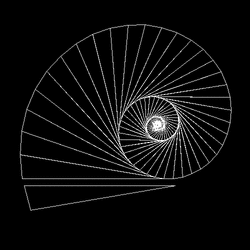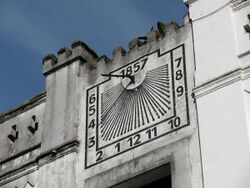Gnomon
Topic: Astronomy
 From HandWiki - Reading time: 6 min
From HandWiki - Reading time: 6 min
This article needs additional citations for verification. (August 2023) (Learn how and when to remove this template message) |
A gnomon (/ˈnoʊˌmɒn, -mən/; from grc γνώμων (gnṓmōn) 'one that knows or examines')[1][2] is the part of a sundial that casts a shadow. The term is used for a variety of purposes in mathematics and other fields.
History
This section needs additional citations for verification. (August 2023) (Learn how and when to remove this template message) |

A painted stick dating from 2300 BC that was excavated at the archeological site of Taosi is the oldest gnomon known in China.[4] The gnomon was widely used in ancient China from the second millennium BC onward in order to determine the changes in seasons, orientation, and geographical latitude. The ancient Chinese used shadow measurements for creating calendars that are mentioned in several ancient texts.[citation needed]
According to the collection of Zhou Chinese poetic anthologies Classic of Poetry, one of the distant ancestors of King Wen of the Zhou dynasty used to measure gnomon shadow lengths to determine the orientation around the 14th century BC.[5][6] The ancient Greek philosopher Anaximander (610–546 BC) is credited with introducing this Babylonian instrument to the Ancient Greeks.[7]
The ancient Greek mathematician and astronomer Oenopides used the phrase drawn gnomon-wise to describe a line drawn perpendicular to another.[8] Later, the term was used for an L-shaped instrument like a steel square used to draw right angles. This shape may explain its use to describe a shape formed by cutting a smaller square from a larger one. Euclid extended the term to the plane figure formed by removing a similar parallelogram from a corner of a larger parallelogram. Indeed, the gnomon is the increment between two successive figurate numbers, including square and triangular numbers.[citation needed]
Definition of Hero of Alexandria
The ancient Greek mathematician and engineer Hero of Alexandria defined a gnomon as that which, when added or subtracted to an entity (number or shape), makes a new entity similar to the starting entity. In this sense Theon of Smyrna used it to describe a number which added to a polygonal number produces the next one of the same type. The most common use in this sense is an odd integer especially when seen as a figurate number between square numbers.Lua error: not enough memory.
Vitruvius
Vitruvius mentions the gnomon as "Lua error: Internal error: The interpreter exited with status 1." in the first sentence of chapter 3 in volume 1 of his book De Architectura. That Latin term "Lua error: Internal error: The interpreter exited with status 1." leaves room for interpretation. Despite its similarity to "Lua error: Internal error: The interpreter exited with status 1." (or its feminine form "Lua error: Internal error: The interpreter exited with status 1."), it appears unlikely that Vitruvius refers to judgement on the one hand or to the design of sundials on the other. It appears to be more appropriate to assume that he refers to geometry, a science upon which gnomons rely heavily. In those days, calculations were carried out geometrically, in stark contrast to the algebraic methods in use today. Thus, it seems that he indirectly refers to mathematics and geodesy.Lua error: Internal error: The interpreter exited with status 1.
Pinhole gnomons
Perforated gnomons projecting a pinhole image of the Sun whose location can be measured to tell the time of day and year were described in the Chinese Zhoubi Suanjing, possibly dating as early as the early Zhou (11th century BC) but surviving only in forms dating to the Eastern Han (3rd century).[9]
In the Middle East and Europe, it was separately credited to the Egyptian astronomer and mathematician Ibn Yunus around AD 1000.[10] The Italian astronomer, mathematician and cosmographer Paolo Toscanelli is associated with the 1475 placement of a bronze plate with a round hole in the dome of the Cathedral of Santa Maria del Fiore in Florence to project an image of the Sun on the cathedral's floor. With markings on the floor it tells the exact time of each midday (reportedly to within half a second) as well as the date of the summer solstice. Italian mathematician, engineer, astronomer and geographer Leonardo Ximenes reconstructed the gnomon according to his new measurements in 1756.[11]
Orientation
Lua error: Internal error: The interpreter exited with status 1.
In the Northern Hemisphere, the shadow-casting edge of a sundial gnomon is normally oriented so that it points due northward and is parallel to the rotational axis of Earth. That is, it is inclined to the northern horizon at an angle that equals the latitude of the sundial's location. At present, such a gnomon should thus point almost precisely at Polaris, as this is within 1° of the north celestial pole.
On some sundials, the gnomon is vertical. These were usually used in former times for observing the altitude of the Sun, especially when on the meridian. The style is the part of the gnomon that casts the shadow. This can change as the Sun moves. For example, the upper west edge of the gnomon might be the style in the morning and the upper east edge might be the style in the afternoon.
In computer graphics
A three-dimensional gnomon is commonly used in CAD and computer graphics as an aid to positioning objects in the virtual world. By convention, the x-axis direction is colored red, the y-axis green and the z-axis blue. NASA astronauts used a gnomon as a photographic tool to indicate local vertical and to display a color chart when they were working on the Moon's surface.
In popular culture
- The Gnomon of Saint-Sulpice inside the Parisian church, Église Saint-Sulpice, built to assist in determining the date of Easter, was fictionalized as a "Rose Line" in the novel The Da Vinci Code.[12]
See also
- MarsDial (Gnomon sent to planet Mars)
Footnotes
- ↑ Lua error: Internal error: The interpreter exited with status 1.. Liddell, Henry George; Scott, Robert; A Greek–English Lexicon at the Perseus Project.
- ↑ Harper, Douglas. "gnomon". Online Etymology Dictionary. https://www.etymonline.com/?term=gnomon.
- ↑ Pietrocola, Giorgio (2005). "gnomon collection". http://www.maecla.it/tartapelago/museo/gnomoni/index.htm.
- ↑ Li, Geng (2014). "Gnomons in Ancient China". in Ruggles, Clive. Handbook of Archaeoastronomy and Ethnoastronomy. Springer New York. July 7, 2014. p. 2095. ISBN 978-1-4614-6141-8.
- ↑ Li, Geng (9 July 2017). "Gnomons in Ancient China". Handbook of Archaeoastronomy and Ethnoastronomy. New York, NY: Springer. pp. 2095–2104. doi:10.1007/978-1-4614-6141-8_219. ISBN 978-1-4614-6140-1. Bibcode: 2015hae..book.2095L.
- ↑ Li, Geng (2014). "Gnomons in Ancient China". in Ruggles, Clive. Handbook of Archaeoastronomy and Ethnoastronomy. Springer New York. July 7, 2014. pp. 2095–2096. ISBN 978-1-4614-6141-8.
- ↑ The 2nd-century Chinese book Nine Chapters on the Mathematical Art claims gnomons were used by the Duke of Zhou (11th century BC). Laërtius, Diogenes. "Life of Anaximander".
- ↑ Heath (1981) pp. 78-79
- ↑ The Asiatic Review. 1969. https://books.google.com/books?id=CyssAQAAIAAJ&q=%22pierced+gnomon%22.
- ↑ Rohr, René R.J. (2012). Sundials: History, Theory, and Practice. ISBN 9780486151700. https://books.google.com/books?id=msaqctAH8OkC&q=perforated&pg=PA6.
- ↑ Suter, Rufus (1964). "Leonardo Ximenes and the Gnomon at the Cathedral of Florence".
- ↑ Sharan Newman, The Real History Behind The Da Vinci Code (Berkley Publishing Group, 2005, p. 268).
Lua error: Internal error: The interpreter exited with status 1.
References
- Gazalé, Midhat J. Gnomons, from Pharaohs to Fractals, Princeton University Press, Princeton, 1999. ISBN:0-691-00514-1.
- Heath, Thomas Little (1981), A History of Greek Mathematics, Dover publications, ISBN 9780486240732 (first published 1921).
- Laërtius, Diogenes, The Lives and Opinions of Eminent Philosophers, trans. C.D. Yonge. London: Henry G. Bohn, 1853.
- Mayall, R. Newton; Mayall, Margaret W., Sundials: Their Construction and Use, Dover Publications, Inc., 1994, ISBN:0-486-41146-X
- Waugh, Albert E., Sundials: Their Theory and Construction, Dover Publications, Inc., 1973, ISBN:0-486-22947-5.
Lua error: Internal error: The interpreter exited with status 1.
Lua error: Internal error: The interpreter exited with status 1.
 KSF
KSF



